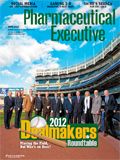From the Editor:The Connections Game
As the old Broadway song goes, June is busting out all over-and true to the season this month's issue stretches the seams with content that ranges from the sublime to the ridiculous.
AS THE OLD BROADWAY SONG GOES, JUNE IS BUSTING OUT ALL OVER—and true to the season this month's issue stretches the seams with content that ranges from the sublime to the ridiculous. Where else, for example, can you read about Big Pharma's intimacy problem with social media? Says author and analyst Mark Chataway, drug companies will never capture the platform's potential until they can match the relentless focus of a political campaign in building on-line connections around a set of highly targeted demographics. While some in industry are nostalgic for the days when a CEO could hit a reporter's camera with a golf club and get away with it, Chataway archly notes the tools of reputation management have changed. He points to the Obama campaign's adept use of social media to create awareness and forge new voting constituencies based on the broadest interpretation of what qualifies as a community: Did you know transgender chefs have issues that deserve the attention of our President?

William Looney
Were Big Pharma to apply the same detail to community building through social media, its reputational status could be transformed, from dull corporate wallflower to an interested, engaged, and prolific citizen—where markets can be grown by saying something new to different people. And all people are patients, at some point.
Once the conversation is started, the question arises how to keep that audience amused. So our second feature this month provides at least a partial answer. If you want to stimulate a patient to do something sensible by himself, then play games—literally. Technology has opened up new ways to apply visual simulations to help providers and patients understand the consequences of health behaviors and to help predict and measure outcomes as participants respond with desirable changes in practice and lifestyle. Senior Editor Ben Comer provides three cases where the science of repetition and the art of contrast are enlisted to induce "learning behaviors," with that final eureka moment of recognition—if I do "x" I will achieve "y"—determined by the patient, no one else. That in turn is the best way to guarantee the intended results.
Our cover picture has the camera set at Yankee Stadium for America's ultimate game: baseball. The story within is our annual tribute to deal-making in the life sciences, in which no exercise in behavior modification is required: All the players this year are single-minded in seeking to acquire prize assets at the lowest possible risk. Our roster of 11 field experts find a growing imbalance between the expectations of society for funded innovations and the daunting complexities of the deal-making process. These range from the challenges of valuing IP, as science leaps ahead of the law; anticipating payer need; funding costly post-marketing obligations imposed by regulators; to forging common ground with academia and other new partners from different functional and geographic settings.
A practical example of just how hard it can be to pony up to market expectations is implicit in our fourth feature, describing Shire's efforts to build a value case for its promising inventory of acquired CNS compounds. Senior Vice President for Specialty R&D Jeffery Jonas describes for Pharm Exec his plans to invigorate this highly important therapeutic class through an aggressive approach to new indications and commercializing leads from promising outside assets. This is a mission he calls "search and rescue," a variation of the company's more familiar description of itself as a "search and develop" enterprise.
Our final entry brings us truly to the sublime, in the form of an exclusive back page interview with management and innovation expert Clayton Christensen of the Harvard Business School. Even though Christensen has written a book applying his insights about how organizations innovate to pharmaceuticals, he still approaches our industry with an outsiders' perspective. He believes CEOs need to seek out views from non-traditional players, to confront regulatory and financial pressures that force an excessive focus on short-term results, and to take more time to think—period. Innovation in medicines faces significant challenges from a changing payer environment, but progress is possible because part of the solution is in the industry's own hands. It starts with changing the internal funding incentives that create a bias toward projects that conform to the current business model, which by definition means they are not innovative.
Significantly, Christensen says he would welcome a more structured encounter with the industry's "deep thinkers;" it is gratifying he makes his reference in the plural form. It brings us back to the notion of community: We are all our brothers' keeper, and there is much to be done.
William Looney
Editor-in-Chief
Follow Bill on Twitter:
@BillPharmExec

Cell and Gene Therapy Check-in 2024
January 18th 2024Fran Gregory, VP of Emerging Therapies, Cardinal Health discusses her career, how both CAR-T therapies and personalization have been gaining momentum and what kind of progress we expect to see from them, some of the biggest hurdles facing their section of the industry, the importance of patient advocacy and so much more.